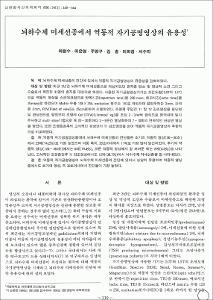뇌하수체 미세선종에서 역동적 자기공명영상의 유용성
- Keimyung Author(s)
- Rhee, Chang Soo; Joo, Yang Gu; Kim, Hong; Lee, Hee Jung; Suh, Soo Jhi
- Department
- Dept. of Radiology (영상의학)
- Journal Title
- 대한방사선의학회지
- Issued Date
- 1996
- Volume
- 34
- Issue
- 3
- Abstract
- Purpose: To investigate the usefulness of dynamic MR imaging in the diagnosis of pituitary microadenomas. Materials and Methods: Dynamic MR imaging was performed in 31 patients with suspicious pituitary microadenoma. The MR examination was performed on a 2.0T or 1.5T superconductive MR unit using spin echo(SE) technique with arepetition time of 200msec, echo time of 15 msec, 128 ?256 matrix and one excitation. Actual sampling time perimage was 26 seconds. The field of view was 25cm and a section thickness of 3mm with 2mm gap was chosen. After arapid hand injection(2-3ml/sec) of Gd-DTPA(0.1 mmol/kg of body weight), dynamic coronal plane MR images wereobtained every 20-30 seconds for 3-5 minutes. Between never and ten serial images were usually obtained. Afterdynamic MR imaging, routine SE T1-weighted images(T1WI) were obtained in the same plane as dynamic images, anddetection rates of pituitary microadenoma using dynamic MR imaging and using routine enhanced T1WI, wereretrospectively compared. Results: On early dynamic images(30
90 seconds), 23 of 31 adenomas(74.2%) were wellvisualized, with a clear border ; of particular note is the fact that 11 of the 31 were well visualized at30-second dynamic image. On late dynamic images(120-180 seconds), six microadeomas(19.4%) were well-visualized and; two(6.5%) were well-visualized throughout on all dynamic images. Meanwhile, 12 of 31 microadenomas(38.7%) werewell-visualized on routine Gd-DTPA enhanced T1WI. Conclusion: Dynamic MR imaging with Gd-DTPA bolus injection wasthe most useful technique for the detection of pituitary microadenomas, especially on early-phase dynamic images.
Key word: Pituitary , neoplasmsPituitary , MR
목적: 뇌하수체 미세선종의 진단에 있어서 역동적 자기공명영상의 유용성을 검토하였다.
대상 및 방법: 최근 3년간 뇌하수체 미세선종으로 의심되었던 환자 중 임상 및 영상적 소견 그리고 수술로서 확진된 31명의 환자를 대상으로 하였다. 사용한 자기공명영상기기는 초전도형(2.0T와 1.5T)으로 역동적 영상을 스핀에코법으로 반복시간(repetition time)을 200msec, 에코시간(echo time)을 15msec로 하였으며 Matrix 수를 128☓256, excitation 횟수는 1회로 하였으며 절편두께는 3mm, 간격은 2mm, FOV(Field of view)는 25cm으로 하여 시행하였다. 조영제 주입전 T1 및 T2 강조영상을 횡단면 및 관상면으로 얻었으며 조영제 Gd-DTPA(0.1mmol/kg)를 초당 2-3ml씩 급속으로 정맥내에 일시 주사하고 multi-slice기법으로 매 20-30초마다 3-5분간 영상화하여 7-10회의 연속적인 관상면 영상을 얻었다. 또한 조영증강후의 고식적인 관상면의 T1 강조영상을 얻어 역동적 자기공명영상과 후향적으로 비교하였다.
결과 : 역동적 자기공명영상 중에서 뇌하수체 미세선종의 진단율은 초기의 역동적 영상(30-90초)에서 23예74.2%)로 가장 높았으며 이중 특히, 30초이내에서 11예로 가장 많이 발견되었다. 후기의 역동적 영상(120-180초)에서는 6예(19.4%), 모든 역동적 영상에서 잘 보여준 예는 2예(6.5%)로 나타났다. 고식적인 조영증강후 T1 강조영상에서도 12예(38.7%)에서 뇌하수체 미세선종을 잘 나타내였다.
결론 : 역동적 자기공명영상이 뇌하수체 미세선종의 진단에 있어서 상당히 유용하며 역동적 영상 중에서도 초기의 영상, 즉 30초 이내에서 진단율이 가장 높았다.
- Alternative Title
- Usefulness of Dynamic Magnetic Resonance Imaging in Pituitary Microadenomas
- Publisher
- School of Medicine
- Citation
- 이창수 et al. (1996). 뇌하수체 미세선종에서 역동적 자기공명영상의 유용성. 대한방사선의학회지, 34(3), 339–344.
- Type
- Article
- ISSN
- 0301-2867
- Appears in Collections:
- 1. School of Medicine (의과대학) > Dept. of Radiology (영상의학)
- 파일 목록
-
-
Download
 oak-bbb-994.pdf
기타 데이터 / 3.55 MB / Adobe PDF
oak-bbb-994.pdf
기타 데이터 / 3.55 MB / Adobe PDF
-
Items in Repository are protected by copyright, with all rights reserved, unless otherwise indicated.